|
I've heard it suggested that the greatest get-out clause in modern
cinema is the caption that opens the first Star
Wars film – "A long time ago in a galaxy
far away" establishes not only that the worlds depicted
within the film are not directly related to our own, but that these events
happened not in some version of our future, but in
someone else's past. With that simple statement George Lucas told his
audience that in this world anything goes, and if the
fashions look dated, if a laser pistol looks like a WW2
Mauser, then that's because the universe in which this film takes place developed along different lines to our own, and that any such similarities are thus purely
coincidental. But running a close second to this must
be "Based on a true story", where "based on" allows the filmmaker to get creative with (a cynical view might be "trade
on the notoriety of") a real-life character or event and fictionalise aspects of both whilst presenting them as fact. The extent to which this is
seen as a good or bad thing depends in part on the degree
to which events and characters are drawn from reality:
no-one really had issues with the fact that Tobe Hooper's The Texas Chain Saw Massacre bore an only
passing resemblance to the activities of Ed Gein, but
Oliver Stone has been repeatedly ticked off for juggling
with the facts in movies such as JFK and Nixon.
Based
as it is on the life of multiple-murderer Aileen Wuornos,
or at least a small part of it, Monster carries the aforementioned disclaimer, but ultimately
sets itself up as a true catalogue of the events that
ultimately led to the arrest and execution of a woman
who was incorrectly dubbed "America's first female serial
killer." Although the names of all of the characters except
Wuornos have been changed, presumably because the people in question are
all still alive (as far as the movie world is concerned, you're fair game once
you're dead), many of the principal figures
are drawn from real life and the event timeline is, for
the most part, fairly accurate. But debut writer-director
Patty Jenkins, having apparently researched her movie
thoroughly, still plays fairly loose with the truth, and having adopted a specific viewpoint for her story, she massages
the facts through alteration and omission to
avoid contradicting it. The result is a film that is at
times impressive in its recreation of recorded events,
and at others misleading, romanticised, and frankly a
little cheesy.
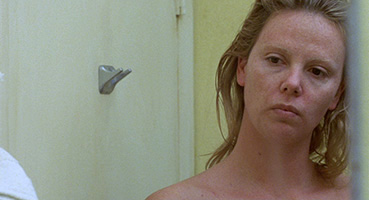
The story of Aileen Wuornos is a complex one. To this day, much of it remains
the subject of speculation, and whether she killed in self-defence
or cold blood has never been definitively confirmed.
Wuornos always maintained that she was brutally raped
by her first victim, Richard Mallory (credence was later
given to this when it was revealed that Mallory
had previously spent five years in jail for violent rape in
another state, but no retrial was granted on the basis of
this new evidence) and that her other victims had either
attacked or attempted to assault her and that she was
acting purely in self defence. Towards the end of her
twelve years on death row she unexpectedly changed her
plea, claiming that she had killed them for their money
only. But in their compelling documentary, Aileen:
Life and Death of a Serial Killer, filmmakers
Nick Broomfield and Joan Churchill cast considerable doubt
on this, the suspicion being that she had altered her story in
order to speed up her execution as she was no longer able to
cope with her death row existence.
It
is these killings and Aileen's relationship with her
lover Tyria Moore (here renamed Selby) that form the
crux of a film that has all the ingredients
of a standard teenage drama. A wrong 'un with
a dark past meets the right girl and, despite the disapproval
of the girl's guardians, the two run off together. The
relationship changes both of their lives, but the past
eventually catches up with them with tragic results, testing
their love and ultimately destroying them. Of course the
difference here is that both of the characters are women,
and it is to the film's considerable credit that it presents
their relationship as a natural and loving one,
the problems that arise having nothing to do with gender
or sexual preference. But even at this early stage the
film has started to stray. The use of Aileen's POV voice-over
heavily romanticises her grim childhood and her early
days as a call girl – she was chasing a dream, the film
suggests, and was getting in cars with men not to make money
after she was thrown out of home (living in the woods
as she was, if a punter took her to a motel for sex, it would offer
her the chance to wash and warm herself), but
because she believed that any one of them might be movie producer
who would 'discover' her and make her into a star. This
also suggests a desire to be famous at all costs, a low-key
speculation thrown in to the mix of Why Aileen Killed.
Cut
(in a smartly executed edit) to Aileen sitting beneath an
underpass contemplating suicide, and one last drink
lands her by chance in a gay bar and introduces her to Selby, whose attempted pick-up she angrily rejects, telling
her in no uncertain terms that she is not of that persuasion.
The movie chooses to use this awakening of her until-then
undiscovered lesbianism as a turning point for Aileen,
whereas in truth this was not her first gay relationship
and it seems likely that she knew full well she was entering
a gay bar, probably in search of the very companionship
she found. What is not in dispute is the importance of
the relationship with Tyria/Selby to Aileen – in a life
that was characterised by abuse and exploitation, this
was the only true love she ever knew.
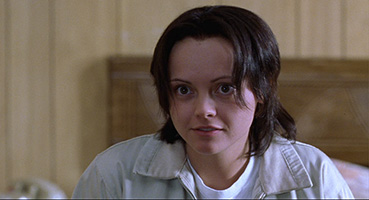
It's the presentation of Selby that best illustrates the film's
schizophrenic attitude to the facts of the case. It's
deemed OK to present Wuornos as she was, a woman of earthy appearance whose tough life is reflected in her looks and her attitude,
in part because her case is so well documented and her face so widely known. She's also presented as an essentially masculine
figure, where the values of aggression and toughness are
more important than beauty, something symbolically represented
by the replacement of the real-world Wuornos's .22
pistol with a .44 Magnum, the gun of choice for Dirty
Harry and a favourite example of a firearm as an all-destroying
phallus. But we're still in an American movie with an
audience demographic in mind, so to balance this we
have Christina Ricci's wide-eyed cuteness as Selby, a
woman just about anyone can appreciate the appeal of (well,
not the regulars in the gay bar, it seems) and a far
cry from the hardened features of the woman on whom she
is based. You can't help but imagine the discussion –
"Goddamn it, we have to sell this – at least one of the lead characters has to be pretty!"
The
first murder extends this fact/fiction approach. With
no hard evidence as to exactly what took place save for the number of shots fired, the conversation and activity
during all of the depicted killings are a matter of speculation.
Yet for the encounter with the Richard Mallory stand-in,
writer-director Jenkins has chosen to take Wuornos's account pretty much at her word
(though aggressive invasion by a foreign object
has replaced rape, something that actually comes across as nastier) and presents Wuornos very much as the victim
and her attacker's death as a cathartic necessity. The film also uses this assault and its aftermath to both complicate and
propel forward the still undeveloped relationship between
Wuornos and Selby, whereas in truth Wuornos and Moore had been together
for three years when this incident occured. This proves something of a blueprint for the rest of the film, with fact and fiction
blended for dramatic effect, sometimes to the detriment
of the story being told, as the truth, though more complicated
and with fewer straightforward answers, is often more
interesting than the over-familiar relationship clichés
that are sometimes employed in its name.
Though
his earlier rape conviction has leant credence to Wuornos's account
of Mallory's supposed assault, the
other six killings have remained a subject for sometimes wild
theorising, from the Freudian (she was killing her father
over and over again), to the stupidly sensationalist (she
was a lesbian man-hater), to Wuornos's own claim that she was acting in self-defence and her later assertion that it was all a matter of robbery and eliminating witnesses. Monster seems keen to flirt with several
of these theories, and following the self-defence plea of the first attack,
Wournos is transformed into an avenging angel of the Christian moral
right (oxymoron time again), killing a punter after he
requests she call him daddy while they do the deed and
prompting her to spit "fucking child molester!"
after she has shot him, trading on what has of late become
a tiresomely lazy way of labeling someone as deserving
all they get. All of the early encounters present Wuornos
as the innocent and her punters as sleazy, abusive scumbags, which has the effect of shaping Aileen into a female Travis Bickle, the real rain that
has come to wash the scum off the streets. A particularly
fanciful sequence in which she tries for a secretarial
job and is soundly humiliated by another pompously judgemental
male ensures that we know she tried everything in her
power to avoid this life direction, and the seedy cop who drives
her to a garage and demands a blow-job confirms that the
police will offer no help to someone
like her. To hammer the point home, Wuornos is subjected
to further humiliation by the cop in question, and it's revealed that when he arrested her on a previous occasion he
almost broke her skull. In this world, all men really
are scum.
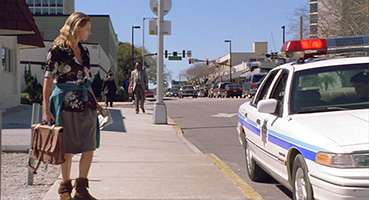
As
money becomes tight and Selby pressures Aileen to return
to prostitution, the prinicipal motivation for the killings switches to robbery
tinged with a dose of man-hating, with the moralistic undertone
still ever-present (before killing a man who turns out
to be an ex-cop, Wuornos sneers at his unfaithful attitude
to his wife, then tells him how much she loathes men).
This is emphasised by the pick-up she lectures about his
desire to play it rough as a prelude to killing him, only
to have him whimper that he's not like that and has never
done this before. He escapes with his life and a quick
hand-job, which Wuornos administers with a look of barely
controlled revulsion. The final killing, in which a man
who was simply offering to help Wuornos pleads for his
life and is shot to cries of "I'm sorry!"
suggests that it was here that Wuornos unwittingly crossed the line.
Of course, now that she's killed someone that the
film has marked as undeserving, it's finally time for the police
to wake up and catch her. This presents us with a
rather tabloid view of the whole situation, reviving memories
of the so-called Yorkshire Ripper, Peter Sutcliffe, who
did not become a subject of outrage for the British press
until he killed his first non-prostitute.
As
events come to a head and the police start to close in,
the film is back on more solidly factual ground, though remains dramatically shakey. Wuornos's eventual arrest is even filmed in
the actual biker bar in which it took place, though this
cuts little ice given the games played with the
truth elsewhere. The decision not to even mention the
short but non-violent relationship Wuornos had with Dick
Mills after Tyria had left her may have been made for
dramatic flow, but it also serves to re-enforce the presentation
of Aileen as a woman who, with the exception of Bruce
Dern's easy-going old (and non-sexual) sage, only ever
received abuse from the men she encountered, never kindness
or even tolerance. If truth and legend collide, print
the legend.
The
final courtroom scenes are handled in ultra-brief style,
but even then we are carefully steered to see Aileen as
a tragic anti-hero. Her defiant, angry response to her
verdict – "May you rot in hell! Sending a raped woman
to death!" – is close to the what she actually said. Yet by omitting her furiously hateful "I hope your wife
and kids get raped – right in the ass!" the film avoids any
willful nastiness on Aileen's part and gets to
keep her as a victim, having been betrayed by the woman
she loved and sentenced to death by an uncaring (male)
judge who is uninterested in her claims that she was trying
to defend herself. All of which is true, from a certain
perspective, but a look at the documentary footage of
this event shows just how sanitised and unambiguous the
film has become by this stage.
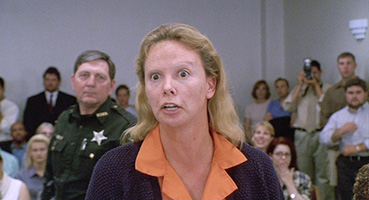
Though
ultimately even a film that is based on fact must stand and fall
by its effectiveness as a drama, it is its very relation
to the real Wuornos case and the news footage, interview
material and documentaries surrounding it, that serves
to illustrate both the film's strengths and its weaknesses.
Central to this is Charlize Theron's performance as Wuornos.
A traditional Hollywood beauty, she has transformed herself
here both facially and physically (teaming her with the
diminutive Ricci emphasises her height, another male characteristic),
and she has clearly studied footage of Wuornos in full vitriolic
flow. As an impersonation it is sometimes uncannily accurate, but
despite the widespread acclaim and the Academy Award,
there is a nagging sense that the entire performance was
based on footage of Wuornos after she had
spent twelve years on death row, when so long spent in isolation
had turned the calm, communicative and lucid talker seen in
Nick Broomfield's 1992 Aileen
Wuornos: The Selling of a Serial Killer into a sometimes wild-eyed woman on the edge of insanity
whose mood could change in a second. Theron plays her
this way for much of the film, volatile, extremely unstable,
and almost always a couple of twitchy steps away from
violence. It's a showy and at times fascinating portrayal,
but is also disappointingly restrictive. Comparisons
with the documentary footage of the real-life Wuornos
serve to highlight both the impressive accuracy of aspects
of Theron's performance and the fact that the Wuornos
herself actually had a greater range, so to speak.
There
is an unfussy efficiency to much of the film that serves
the storytelling well, but this is repeatedly undermined
by moments of quite horrible Hollywood clunkiness, almost
always surrounding the relationship between Aileen and
Selby. Music is the chief offender here, and is often
either poorly used or just plain annoying. This is first
evident in the rather twee musical accompaniment
to Aileen and Selby's first, largely innocence night together,
but really makes its mark at a skating rink as the pair
venture out together and finally kiss, and a horribly
cheesy pop song is cranked up in an explosion of Hollywood
romantic mawkishness. The scene is clearly designed to
show Wuornos as a woman of love, passion and commitment,
but it's so crassly handled that I, for one, was having
trouble holding down my lunch. Later, as Aileen emerges
from the bathroom ready to really commit to their relationship,
another ghastly pop singer warbles loudly, "I don't
really know her....but I think I could love her...."
and on Aileen's proclamation of love to Selby, the warbler
pipes up with "What a beautiful feeling..."
followed by some nightmarish guitar twanging that had
me scrabbling for the volume control. Though things never
get this bad again, this state-the-bleedin'-obvious use
of music pops up several times, notably when Wuornos
is cutting out newspaper clippings of her crimes (very serial killer) and her relationship with Selby is straining,
and the radio blurts out: "I'm gonna keep on
lovin' you.....'cause it's the only thing I wanna do..."
There is also a tendency to build to key events – one
of the shootings, the verdict at her trial – with an onslaught
of electronic guitar twanging that rises to a crescendo
and seems to shout "HERE COMES A BIG MOMENT!" at
you in an extraordinarily unsubtle way.
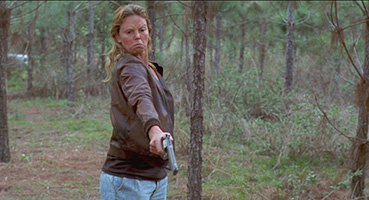
As
we get closer to the end, the film slips more and more
into familiar troubled relationship territory, and Wuornos's
tearful emotional collapse at the bus station comes across
as an uncomfortable mix of tragedy, guilt and over-the-top
histrionics. By then, this complicated true-life story
has been reduced to the level of B-movie melodrama, which
has prompted more than one reviewer to note the similarity
of this film's style and approach to that of the exploitation
features of Roger Corman. Viewed on that level, Monster certainly has a lot going for it – as it never
flags, creates an effective anti-hero (in part by making
almost everyone else seem worse), and is energetically
performed. But there is a sense that with a little less
reliance on twee romanticism, storytelling cliché,
over-simplification and drama-inspired fact-bending, this
could have been much more powerful and affecting work.
Framed
at 1.85:1 and anamorphically enhanced, the transfer is,
for the large part very pleasing – colour and contrast are
impressive throughout, and sharpness is generally good,
if a tad soft in a couple of places. There is some artefacting
in areas of similar colour such as the gay bar where Aileen
and Selby meet – the background shimmers quite a bit here.
On the whole, though, night-time scenes are very well rendered
and daylight shots are very good.
Both
a 5.1 and a DTS track have been included, the main difference
between them being one of volume. The surrounds are reasonably
well used, though more for music and atmospheric sound effects
than specifically directed sounds (a lot of musical elements
seem to end up at the back). Surprisingly little use seems
to be made of the subwoofer, but on the whole this is a
pleasing enough, if unadventurous mix.
You
can pretty much discount the three trailers that precede
the film as true extras – they are there to sell other Columbia
Tristar titles and cannot be skipped, but pressing the menu
button on your remote should sort that.
The
Making of Monster featurette is
4:3 and stereo and is effectively a 15 minute EPK. There
is plenty of talk of the film's intention to get deeper
than any other look at the Wuornos story, plus a good deal of
the sort of back-slapping and self-congratulation that we
have come to expect from these electronic press kits. It also touches on Theron's
make-up, and the fact that some of the film was shot on
the locations at which the real events took place. Image quality here is somewhat variable,
especially the film extracts.
Theatrical
Trailer runs for just over 2 minutes, is non-anamorphic
1.85:1 and stereo and gives a reasonable flavour of the
film, including that music.
The
International Trailer is also
non-anamorphic 1.85:1 and stereo and actually sells the
film more effectively by making the love story element seem
less tacky. It runs for 2 minutes 20 seconds.
Monster
"Surrounded" is a 30 second promo
for the soundtrack album, something I personally will not
by buying.
Film
Mixing Demo is a moderately interesting extra
that allows you to play a 2 minute sequence from the film
with just the dialogue, music of effects tracks, or combinations
of them.
Interview
with Patty Jenkins and BT or, as it announces
itself when the film starts, Monster – Evolution of
the Score is a 15 minute featurette presented in anamorphic
16:9 and, astonishingly, DTS (there is also a 2 channel
soundtrack), though this is for the music rather than the
interview material, which is underscored by some very audible
tape hiss in places. The content has director Patty Jenkins
and composer of the film's music, known as BT, discussing
the score and the unusually wide 5.1 spread of the mix.
Once again, there is a fair amount of back-slapping, but
also a reasonable attempt to explain how the score came technically and artistically
together. Of course, as someone who found
the score seriously irritating, this was not an extra that
thrilled me, but if you do like the music then
this is definitely for you, though Jenkins' very American
over-enthusiasm can grate a bit.
The
Aileen Wuornos story is by turns fascinating, sad and disturbing,
and is way too complex for any single film to do full justice
to. Monster has been widely hailed for
its central performance, its authenticity, and its feeling
for the character of Wuornos herself. Despite its very real
virtues, I remain largely unconvinced. For me, Monster feels like an old-style exploitation movie in
the ill-fitting coat of serious drama, one that sometimes visibly strains at
the seams. Efficient rather than inspired, and featuring
a central performance that is both impressive and a little
narrow in scope, it too often lets serious drama slip into
the realms of romantic cliché, something the music
score seems almost designed to hammer home. This aside, there
is a fascinating irony in the fact that Theron won her Oscar
for playing Wuornos on 29th February, that leap year day that only occurs
once every four years and, yes, the real-life Aileen's birthday.
And despite my own issues with the film, part of me can't
help thinking that Aileen herself would have rather
liked it.
This
disc itself is a reasonable package, a decent transfer,
a DTS soundtrack and a couple of OK extras. Fans of the
film may well mourn the lack of a commentary track, but
Jenkins' over-enthusiasm in the extra features leaves me
happy enough with the decision. Definitely take a look at
Monster, but then see the Nick Broomfield
documentary double on Wuornos, which for my money are more
gripping, more disturbing, and oddly enough, more emotionally
affecting.
|